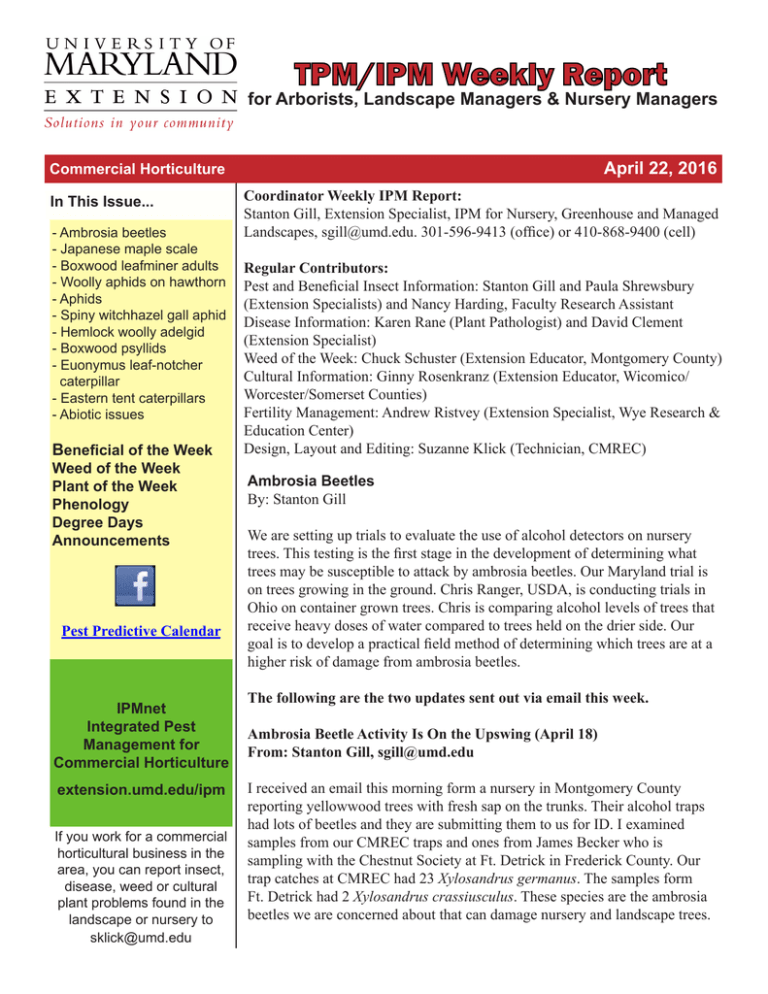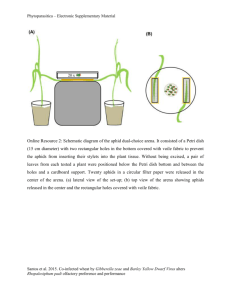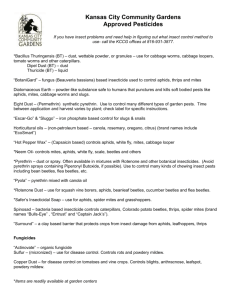TPM/IPM Weekly Report for Arborists, Landscape Managers & Nursery Managers April
advertisement

TPM/IPM Weekly Report for Arborists, Landscape Managers & Nursery Managers Commercial Horticulture In This Issue... - Ambrosia beetles - Japanese maple scale - Boxwood leafminer adults - Woolly aphids on hawthorn - Aphids - Spiny witchhazel gall aphid - Hemlock woolly adelgid - Boxwood psyllids - Euonymus leaf-notcher caterpillar - Eastern tent caterpillars - Abiotic issues Beneficial of the Week Weed of the Week Plant of the Week Phenology Degree Days Announcements Pest Predictive Calendar IPMnet Integrated Pest Management for Commercial Horticulture extension.umd.edu/ipm If you work for a commercial horticultural business in the area, you can report insect, disease, weed or cultural plant problems found in the landscape or nursery to sklick@umd.edu April 22, 2016 Coordinator Weekly IPM Report: Stanton Gill, Extension Specialist, IPM for Nursery, Greenhouse and Managed Landscapes, sgill@umd.edu. 301-596-9413 (office) or 410-868-9400 (cell) Regular Contributors: Pest and Beneficial Insect Information: Stanton Gill and Paula Shrewsbury (Extension Specialists) and Nancy Harding, Faculty Research Assistant Disease Information: Karen Rane (Plant Pathologist) and David Clement (Extension Specialist) Weed of the Week: Chuck Schuster (Extension Educator, Montgomery County) Cultural Information: Ginny Rosenkranz (Extension Educator, Wicomico/ Worcester/Somerset Counties) Fertility Management: Andrew Ristvey (Extension Specialist, Wye Research & Education Center) Design, Layout and Editing: Suzanne Klick (Technician, CMREC) Ambrosia Beetles By: Stanton Gill We are setting up trials to evaluate the use of alcohol detectors on nursery trees. This testing is the first stage in the development of determining what trees may be susceptible to attack by ambrosia beetles. Our Maryland trial is on trees growing in the ground. Chris Ranger, USDA, is conducting trials in Ohio on container grown trees. Chris is comparing alcohol levels of trees that receive heavy doses of water compared to trees held on the drier side. Our goal is to develop a practical field method of determining which trees are at a higher risk of damage from ambrosia beetles. The following are the two updates sent out via email this week. Ambrosia Beetle Activity Is On the Upswing (April 18) From: Stanton Gill, sgill@umd.edu I received an email this morning form a nursery in Montgomery County reporting yellowwood trees with fresh sap on the trunks. Their alcohol traps had lots of beetles and they are submitting them to us for ID. I examined samples from our CMREC traps and ones from James Becker who is sampling with the Chestnut Society at Ft. Detrick in Frederick County. Our trap catches at CMREC had 23 Xylosandrus germanus. The samples form Ft. Detrick had 2 Xylosandrus crassiusculus. These species are the ambrosia beetles we are concerned about that can damage nursery and landscape trees. It is predicted to reach 80 °F today and stay warm through the week. I think it is finally time to pull the trigger if you are going to apply either permethrin or bifenthrin (Talstar) to the trunk of susceptible species. Styrax, yellowwood and redbud would be high on my list of susceptible trees. Mid-Week Ambrosia Beetle Update (April 20) From: Stanton Gill We received confirmation from Marie Rojas in Darnestown and Steve Dubik in Frederick that they are finding dogwood and styrax that are actively being attacked by ambrosia beetles this week. On Tuesday, late in the day, I examined alcohol trap samples from Union Bridge (Carroll County) and Gaithersburg (Montgomery County) and both trapping sites have Xylosandrus germanus in fairly large numbers in their trap catches. To monitor for Xylosandrus ambrosia beetles, look for wet areas and One note - As you apply the pyrethroids to the trunk of trees to be developing frass tubes on tree trunks protected, try to use low pressure and do not use an air blast sprayer that slops the pesticide all over the nursery or landscape. The pyrethroids are very hard on predators and parasites. So, the objective is to direct the spray just to the trunk and main branches to minimize impact on beneficials. Japanese Maple Scale – Interesting Developments By: Stanton Gill We are conducting trials in 2016 to evaluate two systemic insecticides for Japanese maple scale control. As part of this trial we had to examine branch samples heavily infested with Japanese maple scale. In the majority of the cases, Japanese maple scale overwinters as 2nd instar males and females which mature into third instar mature females and pupating males in late May to early June. When we were taking the pre-treatment counts we found 5 adult males and 8 mature females. I am not sure if the unusually warm fall which extended into late December sped up the development or some other factor has come into play here. I sent pictures of the adult male to John Davidson for confirmation and he felt they were male JMS. I will look at samples from several other sites and see if the ones we looked at were an oddity or whether we had a partial generation try to come out during the warm weather last fall. This adult male was found on samples heavily infested with Japanese maple scale (JMS); the tentative identification is a JMS adult male Boxwood Leafminer Adults By: Stanton Gill Paul Wolfe, Integrated Plant Care, called in to report heavy adult boxwood leafminer activity in Bethesda on April 20. If you are going to try to control adults now appears to be the time in central Maryland. 2 Woolly Aphids on ‘Winter King’ Hawthorn By: Nancy Harding, UMD At first glance you might mistake the purplish/red and curling leaves on this Crataegus viridis ‘Winter King’ as winter damage since so many other landscape plants this year have had winter injury. However, if you take a closer look by unfurling the leaf you will probably discover early instars of woolly aphids. The images below show the distortion damage and wooly aphids (indicated by black arrow) that were found on April 18 in Bowie. In addition, these sucking phloem-feeding aphids produce a sticky, sweet by-product called honeydew. Ants find honeydew irresistible and are often associated with woolly aphid infestations. The accumulated degree days in Bowie on April 18 were 188DD. Control: Heavy infestations of woolly aphids rarely occur as their numbers are kept low with natural predators like lacewings, lady beetles, hover flies, parasitic wasps, and birds. Goldfinches commonly feed on these aphids. Look for signs of parasitized aphids - they stop producing wax and become discolored (mummified). A circular exit hole made by the parasitoid can sometimes be seen in the aphid mummy’s upper surface. However, if large infestations occur, horticultural oil or insecticidal soap sprays can be used in the spring. Hawthorn ‘Winter King’ showing curled leaf from aphid feeding (on left). On the right is a woolly aphid (black arrow) with protector ant (red arrow). Photos: N. Harding, UMD Aphids Jessica Frakes, Thrive Inc., found aphids on hawthorn in Alexandria, VA, and on roses and hydrangeas in NW D.C. this week. Look for honeydew, sooty mold, and aphid cast skins on foliage. Also look for high ant activity. The ants protect the aphids from predators and feed on the honeydew secreted by the aphids. Control: If present in the landscape, syrphid fly larvae, lady bird beetles and lacewing larvae are good predators of aphids. Insecticidal oil and horticultural soap can be used and have minimal impact on beneficial insects. 3 Aphid activity is increasing as leaves emerge on woody and herbaceous plants Photos: Jessica Frakes, Thrive, Inc. Spiny Witchhazel Gall Aphid Marie Rojas, IPM Scout, is reporting that spiny witchhazel gall aphids are feeding on the undersides of newly emerging birch leaves in Frederick County. Look for spiny witchhazel gall aphids and damage on witchhazels and birches in the next few weeks. This aphid causes red puckering damage to the foliage of birch and the woolly aphids can be found on the undersides of the leaves. It causes spindle galls on its alternate host which is witchhazel. Control: Most often, control is not necessary. Many natural enemies such as lady bird beetles, syrphid flies and parasitic wasps are active this time of year and usually move into the area to reduce the aphid populations. If populations are high, use a low impact material like horticultural oil to minimize the effect on the beneficial insects that Look for red puckered foliage on birch are present. caused by the spiny witchhazel gall aphid Hemlock Woolly Adelgid By: Stanton Gill George Mozal, Stanbury Tree, and Paul Wolfe, Integrated Plant Care Company, called in to report hemlock woolly adelgid hatch this week. Paul reported it in Bethesda. George reported crawler activity in Reston, VA. Marie Rojas, IPM Scout, is finding eggs, but no hatching yet, within the fluffy egg masses in Beallsville. Look for reddish crawlers as they emerge from the white egg sacs. There is a second generation of crawlers in late summer. Control: 2% horticultural oil is one low risk material that can be applied to control the crawler stage that is active Look for activity of reddish hemlock woolly adelgid crawlers as they emerge from the white egg sacs this week. Boxwood Psyllids Jessica Frakes, Thrive Inc., found boxwood psyllids active this week in Virginia. Look for new leaves starting to become distorted. Pull the leaves apart and look for white wax and active nymphs. Control: The damage is very insignificant in that it only causes new growth to cup slightly so control is usually not necessary. If populations are high, a systemic insecticide would provide the best control. Within the cupped foliage (left), look for the green, waxy coated psyllid (above) 4 Euonymus Leaf-notcher Caterpillar Jody Fetzer, Montgomery Parks, sent an email reporting late instar euonymus leaf-notcher caterpillars active in Reston, VA on April 15. In Maryland, this caterpillar has been reported in Anne Arundel, Prince George’s and Baltimore counties. Control: Since the damage occurs early in the season, control is not always necessary. There is only one generation of this pest and plants can recoup. If you decide to treat, control options include Conserve (spinosad), Talstar (bifenthrin), and Orthene (acephate). Eastern Tent Caterpillars Eastern tent caterpillars continue their tent expansion and feeding. Marty Adams, Bartlett Tree Experts, noted this eastern tent caterpillar infestation is the worst he has seen. Silk web trails are covering the trunk of this cherry in Baltimore and at its base on the ground Photos: Marty Adams, Bartlett Tree Experts Brian Scheck, Maxalea, Inc., photographed this large tent of eastern tent caterpillars on a cherry in Pikesville 5 Abiotic Issues When Mark Schlossberg sent in this photo of a boxwood planting in Timonium, he noted that “other than the orange color, they look fine”. Some boxwood plants turn orange in winter when planted in full sun. Photo: Mark Schlossberg, ProLawn Plus, Inc. Ginny Rosenkranz, UME, photographed this hosta that was damaged from the recent frost Beneficial of the Week By: Paula Shrewsbury, University of Maryland Chinese praying mantises are hatching! It is that time of year when days are getting longer and temperatures warmer. We are seeing more insect activity every week! Last fall, female praying mantises attached their ootheca (egg case) to the stems of various plants. It is in the egg stage that mantids spend the winter. A few weeks ago I found an ootheca of the Chinese praying mantis in my yard and have been observing it ever since. The ootheca is round and brownish in color, about ¾” in diameter, and feels like a lightweight ball of styrofoam (see image). Each ootheca can have 100 to 200 eggs in it. Chinese mantis ootheca (egg mass) with newly emerged nymphs. Photo: P.M. Shrewsbury, UMD To see a video of the mantises emerging go to: https://www. youtube.com/watch?v=2yVcS794btI Last Monday, April 18, I went to check on the ootheca and was pleasantly surprised! Praying mantid babies were starting to emerge from the ootheca! As you can see from the image there is a mass of mantises hanging off the side of the ootheca. The nymphs wriggle their way out of the egg case and look almost worm-like. They hang off of silk and each other as they begin to expand their bodies. Blood and air are pumped through the body as their legs, 6 antennae and other body parts become more distinguishable. They are light colored for a few hours until their exoskeletons harden off. I would estimate over 100 little mantises emerged. You can view a YouTube video of the mantis emerging from the ootheca at: https://www.youtube.com/watch?v=2yVcS794btI. Chinese mantis adults are a bright green color and can reach 4-5” (see image). Mantises are carnivorous and the first instar Chinese mantis will feed on small prey items like aphids or flies. As they get bigger they consume larger prey items. They are sit-and-wait predators. They will sit very still on a plant and when a prey item comes close, the mantis will pounce on the prey and grab it with it raptorial legs. Interestingly, it seems the mantis often starts to feed on the head end of its prey. Mantises are voracious predators and feed on a wide range of insects and spiders, some of which are pests of our plants, others are not. Having mantises and mantis egg cases on plants in your property is an indication of a healthy ecosystem. Chinese praying mantis adult female. Image taken in the fall. Note the large abdomen indicating she will soon be laying eggs. Photo: M. J. Raupp, UMD Newly emerged Chinese mantis nymph that has not expanded its body yet Photo: P.M. Shrewsbury, UMD Weed of the Week By: Chuck Schuster, University of Maryland Extension Soil temperatures continue to rise, rather quickly at the beginning of the week with the warmer weather, and now slightly slower. There have been consistent 48 °F readings in Central Maryland, with the lower shore seeing soils in the low to mid 50 °F range. The weeds are really off and running for the season. Soils are dry in many areas which will affect the efficacy of many pre-emergent herbicides as they require moisture for activation. Rain is in the forecast in some areas for the week’s end. Shepherd’s purse, Capsella bursa-pastoris, is an invasive winter annual weed in the Mustard family. It grows from a ground hugging four to a tall twenty-five inches in total height from a basal rosette. Basal leaves are lance-shaped and up to two and one half inches in length. Stem leaves are alternate, clasping, lance-shaped, narrow, and toothed. The white to pink flowers have four petals and are found on thin spreading stalks that produce heart-shaped, flat seed pods. Each pod can contain up to twenty seeds. Shepherd’s purse reproduces only by seed. Seeds require disturbance for germination and will survive long periods in the soil. This plant prefers dryer climates but can survive on wet sites. The name for this weed comes from the small flat seeds that are produced, triangular in shape, with a seam in the middle. 7 Cultural control in turfgrass includes appropriate mowing height, pH and fertility management. Strong turf is an excellent deterrent to this weed. In garden settings, control it using mulch or other barriers, mechanical hand removal or flaming. Use caution with flaming as it can cause fires with the extremely dry conditions that are currently being experienced. Shepherd’s purse will respond to pre-emergent applications of oryzalin (Surflan), Snapshot, and Dichlobenil (Casoron). Post-emergent control may be obtained using several selective broadleaf herbicides labeled for turf, and nursery. In landscapes this weed can be controlled with many of the non-selective translocated products. Shepherd’s purse only reproduces by seed Photos from PLU NCSI with permission Plant of the Week By: Ginny Rosenkranz, University of Maryland Extension Magnolia soulangiana, saucer magnolia, is a lovely deciduous spring blooming magnolia that is very cold tolerant, growing in USDA zone 4-8. There are many cultivars available including the Little Girl series developed by the National Arboretum which includes ‘Ann’, ‘Betty’, ‘Jane’, ‘Judy’, ‘Pinkie’, ‘’Randy’, ‘Rickie’ and ‘Susan’. This series blooms later in the spring than the species by about 2 weeks to reduce the possibility of frost damage. Magnolia soulangiana ‘Jane’ grows 10-15 feet tall and 8-12 feet wide but will begin to bloom when only 2-3 feet tall. Flower buds are light tan to silver gray and silky to the touch, creating Magnolia soulangiana ‘Jane’ is deep pink in bud and opens to show the white on the inside of the petals an interesting look in winter and very Photos: Ginny Rosenkranz, UME early spring. The flowers open before the leaves emerge and are large cups almost 8 inches in diameter. When the flowers first bloom in April to May, the dark reddish purple color is bright against the soft silver gray bark, but as the flowers open it is easy to see that the petals are dark on the outside and white on the inside. The oval-shaped leaves begin with copper red tints in early spring then expand to about 6 inches long and dark green in color in the summer, eventually changing to bronze copper to yellow hues in the autumn. Magnolia soulangiana ‘Jane’ grows and blooms best in full sun and moist, organically rich, well drained soils. It flowers best if not planted on the south side of buildings as that would warm up early and cause the flowers to bloom early and possibly be subject to frost damage. Potential diseases include leaf spots, anthracnose, canker, dieback and powdery mildew. Insect problems include weevils, scale, thrips and snails. 8 Phenology PLANT Phlox subulata ‘Snowflake’ Pieris floribunda Podophyllum peltatum (mayapple) Trillium pusillum Viburnum prunifolium (black haw viburnum) PLANT STAGE (Bud with color, First bloom, Full bloom, First leaf) Full bloom Full bloom Full leaf and Bud Full bloom Full bloom LOCATION Ellicott City (April 21) Silver Run (April 16) Ellicott City (April 21) Silver Run (April 16) Columbia (April 18) Degree Days (As of April 20) Annapolis Naval Academy (KNAK) 211 Baltimore, MD (KBWI) College Park (KCGS) 239 Dulles Airport (KIAD) Ellicott City (E247) 206 Fairfax, VA (D4092) Frederick (KFDK) 139 Greater Cumberland Reg (KCBE) Gaithersburg (KGAI) 196 Martinsburg, WV (C1672) Natl Arboretum.Reagan Natl (KDCA) 324 Rockville (C2057) Salisbury/Ocean City (KSBY) 254 St. Mary’s City (St. Inigoes, MD-KNUI) Westminster (KDMW) 204 Important Note: We are now using the Online Phenology and Degree-Day Models site. 221 215 275 188 167 167 285 Use the following information to calculate GDD for your site: Select your location from the map Model Category: All models Select Degree-day calculator Thresholds in: Fahrenheit F Lower: 50 Upper: 95 Calculation type: simple average/growing dds Start: Jan 1 US DOT Forum June 8, 2016: 8:00 a.m. to noon Location: 6772 Rockawalkin RD, Hebron, MD MSP Senior Trooper Lambert and Master Trooper Dean will provide an update on changes to the Federal Motor Carrier Regulations and Maryland Transportation Article. This Forum will provide both education and one on one question and answer time. It covers recent changes to FMCSR and the Maryland Transportation Article. Including: Medical certificates; Load securement; Breakaway device; Hub covers; Seatbelt use; Speeding and; no handheld cell phones. 8:00 – 10:00 Presentations on Carrier/Companies responsibilities topics such as: Insurance; Maintaining accident records; Driver qualification files; Drug and alcohol testing and; Maintaining log books and time records. Requirements for training, transporting and incident reporting for HAZMAT materials will be discussed if applicable to the attendees. 10:00 – 11:00 ST Lambert and MT Dean will demonstrate the concepts during a mock inspection of two vehicles. One vehicle will be CDL, the other non-CDL. 11:00 – Noon Open Question and Answer Forum Contact Ginny Rosenkranz, Extension Educator, Commercial Horticulture 410-749-6141 to sign up for this free US DOT Forum 9 Commercial Horticulture Conferences Pesticide Recertification Conference (Eastern Shore) June 3, 2016 Brochure will be posted soon Pesticide Recertification Conference June 10, 2016 Location: Montgomery County Extension Office, Derwood, MD Brochure is posted online Maryland Christmas Tree Association Summer Meeting Saturday June 25, 2016 at Thomas Tree Farm, 3501 Hanover Pike, Manchester, MD For info: wayne@thomastreefarm.com CONTRIBUTORS: Stanton Gill Extension Specialist sgill@umd.edu 410-868-9400 (cell) David Clement Plant Pathologist clement@umd.edu Paula Shrewsbury Extension Specialist pshrewsb@umd.edu Andrew Ristvey Extension Specialist aristvey@umd.edu Karen Rane Plant Pathologist rane@umd.edu Ginny Rosenkranz Extension Educator rosnkrnz@umd.edu Chuck Schuster Extension Educator cfs@umd.edu Nancy Harding Faculty Research Assistant Thank you to the Maryland Arborist Association, the Landscape Contractors Association of MD, D.C. and VA, the Maryland Nursery and Landscape Association, Professional Grounds Management Society, and FALCAN for your financial support in making these weekly reports possible. Photos are by Suzanne Klick or Stanton Gill unless stated otherwise. The information given herein is supplied with the understanding that no discrimination is intended and no endorsement by University of Maryland Extension is implied. University of Maryland Extension programs are open to all citizens without regard to race, color, gender, disability, religion, age, sexual orientation, marital or parental status, or national origin.




